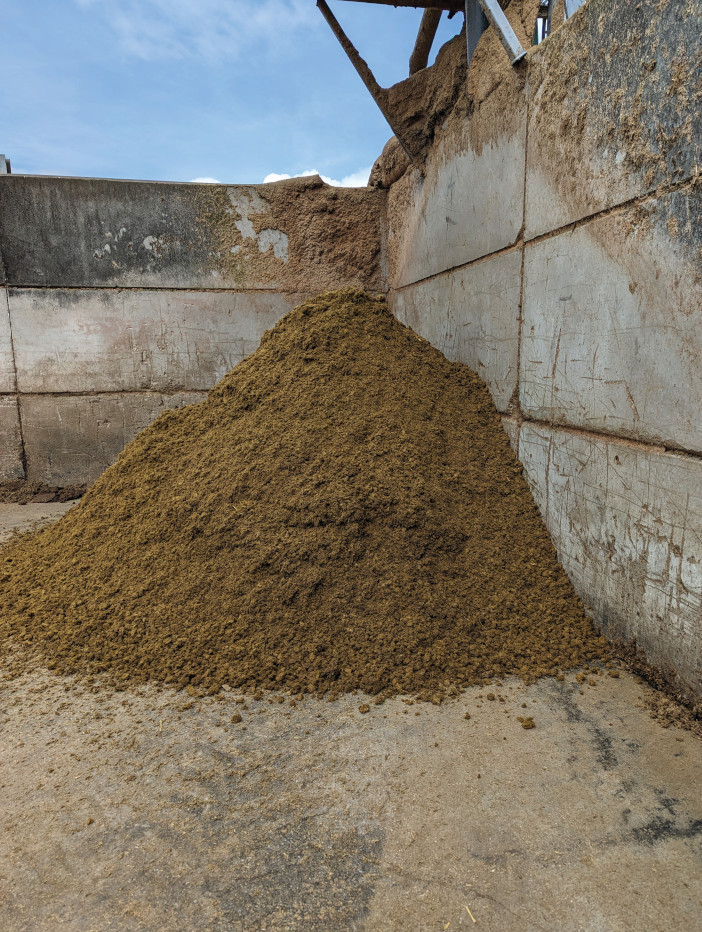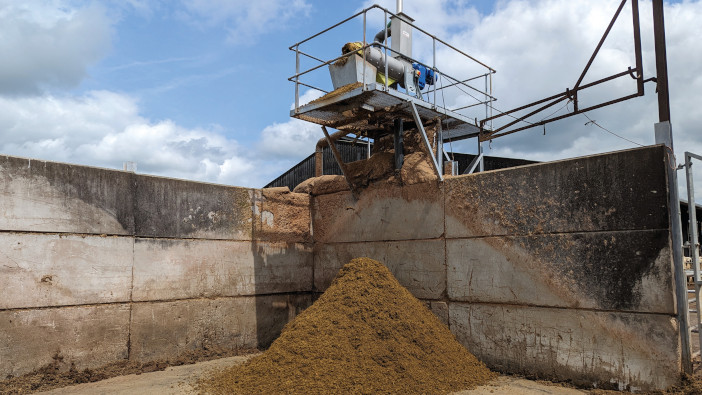Slurry separators can offer multiple benefits to growers utilising them, both in terms of nutrient management and storage. We headed to Bromyard to speak to a user.
Separating slurry into dry matter and liquor provides users with a highly concentrated nitrogen liquid that is consistent enough to spread quickly and easily and a solid fibrous spreading material, containing phosphorus and potassium. As well as providing two easily manageable resources, it also maximises slurry storage, as the liquor is not bulked out by the solid content.
“The limitations on slurry spreading have put a lot of pressure on slurry stores,” explained Mark Roberts, sales manager for Mastek. “Users can expect to see 25% improved utilisation of their slurry storage through separation, and there’s really no limitations on the setup of a farm – as long as they can justify the infrastructure.”
Mastek offers the Sepcom range of separators, distributed under the Saveco brand from conglomerate WAMGroup. Installation requires a reception tank, big enough to deal with at least the daily amount of slurry produced, a gantry for the separator and an area to store the dry matter. The slurry is pumped to the separator from the reception tank, and then the liquor is pumped directly to the main lagoon. If a blockage occurs, or the slurry contains a higher dry matter content, an overflow pipe will return it to the reception tank.
“We offer three models of standard separators, with a possible throughput of 65m3 when using the largest model, requiring just 5.5kW of power. They also have automatic on and off, meaning that when the reception tank reaches a certain capacity, the separator will automatically turn on,” Mr Roberts added.

Putting separation to use
To see one of the units in action, we headed out to Tack Farm, near Bromyard. Henry Lewis runs the family-owned dairy unit, with a 900-head herd, milking 800 for an annual output of 10.5 million litres for Arla. Around 1,200 acres of ground are farmed, with maize and wheat supplementing the grassland. For silage, five grass cuts are taken each year.
“We’ve run separators for 13 years,” Mr Lewis explained. “When we upgraded to a rotary parlour, we were advised to look at our slurry infrastructure and quickly realised the benefits of separating the dry matter.”
The farm installed a 140m3 reception tank for the separator, as well as a walled-off area for the dry matter. “Our first unit worked well but was quite slow. We ran it for seven years and when it came time to replace it, we started to consider the possibility of green bedding,” Mr Lewis said.
The green bedding unit required more power, running on an 11kW motor because of the increased pressure applied to the slurry to produce a far dryer material suitable for bedding.
“We bed on sawdust and it’s incredibly expensive,” said Mr Lewis. “We could see the obvious benefits of using a by-product to produce bedding, but unfortunately it wasn’t suitable for our unit. The separator was then used as a standard unit, but the increased power consumption and growing maintenance costs meant that we looked for a replacement unit this year.”
He opted for the Sepcom horizontal screw separator, with outputs up to 45m3 (although Mr Roberts pointed out that in real conditions, with varying consistencies, this would be closer to 30m3). The reduced power output was very attractive to the business given the price hikes in electricity, as was the automatic functionality.
“We’ve been using the Sepcom for a month and so far, we haven’t had to touch it,” Mr Lewis explained. “That might not sound a lot but because of the sawdust content in the slurry, and the fact that we use small amounts of sand to stop cattle slipping on the concrete, we had previously had a lot of issues with maintenance due to blockages and wearing parts.”
Mr Roberts added that Sepcom uses polymer sections on the auger, which are low maintenance and continually wipes the screen of debris to improve operation. The auger is separated into multiple parts so that sections can be replaced, lowering repair costs.
“Additionally, the gearbox is completely separate from the main body of the separator meaning there is no risk of slurry entering and contaminating the gearbox or electric motor, this is a very good feature which can save a very expensive repair bill”
Mr Lewis uses a contractor to spread the liquor on the grassland and has seen less tainting of the leaf and a quicker uptake of nutrients between silage cuts, keeping the operation efficient. The solids, which is primarily phosphorous and potassium, are spread onto maize and wheat ground on the farm as a soil conditioner, as well as being used on rented ground.
The benefits of slurry separation
Separating slurry produces a nitrogen-heavy liquor, as well as a soil conditioning solid primarily made up of fibres, phosphorous and potassium. Upgrading to a green bedding unit pushes dry matter content up to 40% and can be used as part of a circular on-farm system, however, this is not suitable for all farms and a detailed examination of the cattle housing should be conducted to ensure suitability.
Sepcom also develops a Micro-Filter system, which will further separate the liquor, potentially allowing the separation of specific nutrients to allow growers to take greater control of nutrient applications.
For more information go to www.mastek.ie


